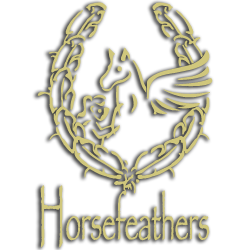Therapeutic Riding
Vaulting
Often equated to gymnastics on horseback, vaulting uses a surcingle to allow riders to perform seven standard movements (called compulsories-mount or vault on, basic seat, flag, mill, scissors, stand and flank) and many freestyle movements on the back of a horse on a lunge line. The therapeutic value of vaulting is immense, and it promotes strength, flexibility, balance, and coordination through the physical moves; as well as confidence, trust, patience, and critical thinking as participants must learn routines and develop the skills necessary to perform these on a moving horse. Traditionally, all three gaits are used, though the intensity of the speed and movements can be easily adjusted for therapeutic programs.
Hippotherapy
Hippotherapy is a physical, occupational, and speech-language therapy treatment strategy that utilizes equine movement as part of an integrated intervention program to achieve functional outcomes. Equine movement provides multidimensional movement, which is variable, rhythmic and repetitive. The horse provides a dynamic base of support, making it an excellent tool for increasing trunk strength and control, balance, building overall postural strength and endurance, addressing weight bearing, and motor planning. Equine movement offers well-modulated sensory input to vestibular, proprioceptive, tactile and visual channels. During gait transitions, the patient must perform subtle adjustments in the trunk to maintain a stable position. When a patient is sitting forward astride the horse, the horse’s walking gait imparts movement responses remarkably similar to the normal human gait. The effects of equine movement on postural control, sensory systems, and motor planning can be used to facilitate coordination and timing, grading of responses, respiratory control, sensory integration skills and attentional skills. Equine movement can be used to facilitate the neurophysiologic systems that support all of our functional daily living skills. At Horsefeathers it would be done with a team: one horse person, the horse, a professional certified therpist, the client, and at least one sidewalker (depending on what the therapist needs).
**Horsefeathers does not currently offer Hippotherapy but we can if an interested client has a certified therpist that wants to work with us**
Driving
Driving can be used as a means of offering students with physical, mental, or emotional disabilities the rewards of interacting with a horse or pony while driving from a carriage – either in the carriage seat or in their own wheelchair, using a carriage specially modified to accommodate wheelchairs. Using a horse and carriage gives participants an alternative to riding, opening up the world of horses to those who may be unable to ride due to weight, balance, physical limitations, fear of heights or other issues.
Therapeutic Driving offers a unique set of skills and benefits, by providing the student with a distinct range of movements and a vast set of motor-sensory experiences. Therapeutic Driving is about imparting knowledge of safety, horses, harnessing and driving skills to children and adults using teamwork. It takes 3-5 volunteers to make one driving turn out! In addition to therapeutic lessons, drivers with a disability who are interested in competing are welcome at traditional carriage driving competitions, such as pleasure driving and combined driving events, where they compete on an equal footing with able-bodied competitors. As with riding, there are precautions to driving.
**Horsefeathers does not currently offer Driving**
Equine-Assisted Psychotherapy
In the grand scheme of things, Equine-assisted Psychotherapy is relatively new to the industry. The clients do not ride. But because the horse mirrors what the client is feeling, a professional counselor is able to used them in private and group sessions as a tool. Confidentiality is huge with this therapy, so at Horsefeathers it would be done with a team: one horse person for safety, the horse, a professional certified counselor and the client.
**Horsefeathers does not currently offer Equine-assisted Psychotherapy but we can if an interested client has a certified counselor that wants to work with us**
Equine-Assisted Activities & Therapies (EAAT) Benefits
The benefits of animal-assisted activities and therapies have been recognized for a long time, but the specific benefits of interacting with horses may be less well known. Working with horses can have a major physical and emotional impact on people with a wide variety of issues and disabilities. Some (but not all) issues and disabilities for which Equine-Assisted Activities & Therapies (EAAT) are useful are listed below in the link with supporting evidence where available.
